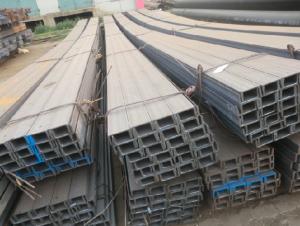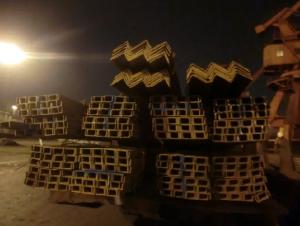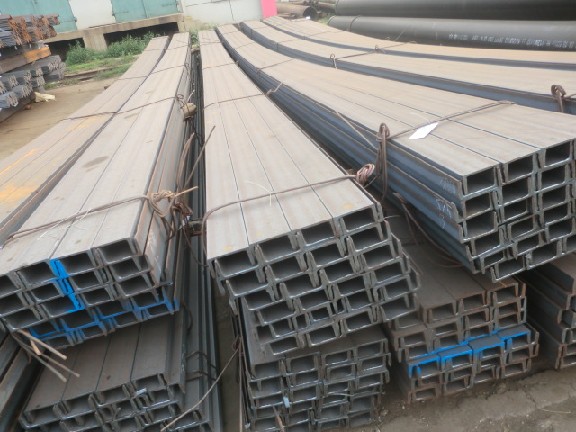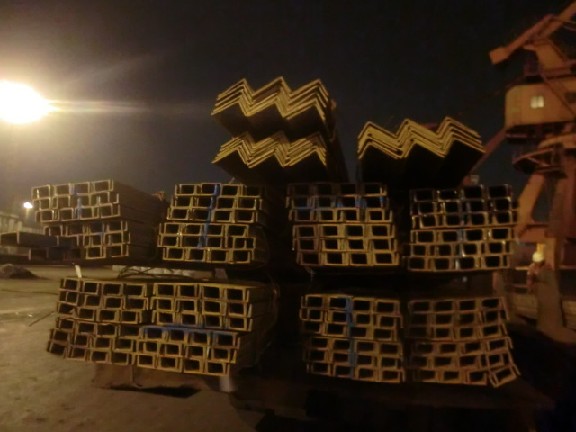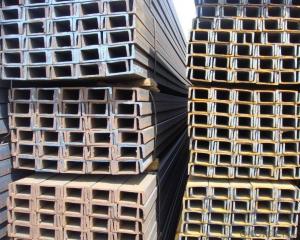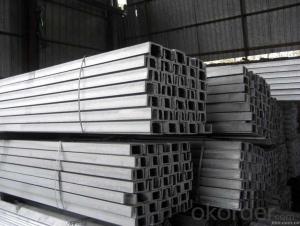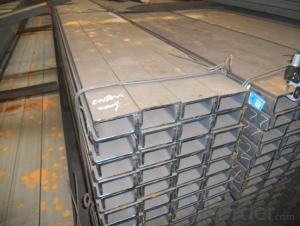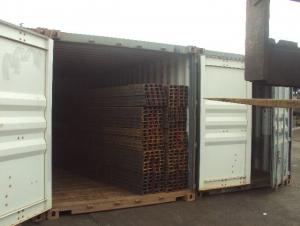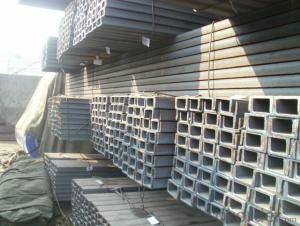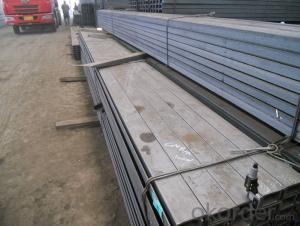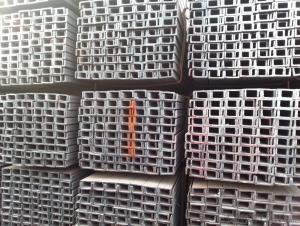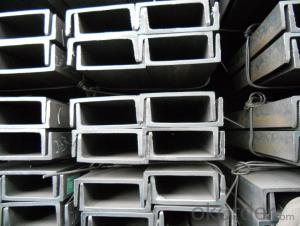JIS Standard U-channel Many Sizes
- Loading Port:
- China Main Port
- Payment Terms:
- TT or LC
- Min Order Qty:
- -
- Supply Capability:
- -
OKorder Service Pledge
OKorder Financial Service
You Might Also Like
Product Description:
OKorder is offering U-channel at great prices with worldwide shipping. Our supplier is a world-class manufacturer of steel, with our products utilized the world over. OKorder annually supplies products to European, North American and Asian markets. We provide quotations within 24 hours of receiving an inquiry and guarantee competitive prices.
Product Applications:
The UPN Channel Steel can be applied to construction of warehouses, workshops, sport stadiums and car parks etc.The hot rolled channel steel belongs to carbon structural steel which is applied to in the field of construction and machinery.In details, the hot rolled channel steel is usually used for arch-itechtural structure, and they could be welded in order to support or hang a vari-ety of facilities. They are also usually used in combination with I beam. Generally,the hot rolled channel steel we supply must possess perfect welding property, riveting property and mechanical property and so on.
Product Advantages:
OKorder's U-channel are durable, strong, and resist corrosion.
Main Product Features:
· Premium quality
· Prompt delivery & seaworthy packing (30 days after receiving deposit)
· Corrosion resistance
· Can be recycled and reused
· Mill test certification
· Professional Service
· Competitive pricing
Product Specifications:
1.Our UPN Channel Steel has lots of advantages, just as followings:
a) At reasonable price and good quality.
b) To be convenient in construction and to save much time and labor.
c) The length of UPN can be manufactured according to customer’s requirements.
d) The UPN Channel Steel has strong mechanical strength.
e). The UPN Channel Steel possesses various kind of fittings, through which it is suitbal for many combinations.
f) Our UPN Channel Steel is attractive in appearance as well as beautiful in design
g) Free from slotted punching
2. The detailed sections of our UPN Channel Steel can be found in table-1
UPN U CHANNEL | Standard h | Sectional b | Dimension s | t | Mass: Kg/m |
| (mm) | (mm) | (mm) | (mm) |
|
80x45 | 80 | 45 | 6.0 | 8.0 | 8.64 |
100X50 | 100 | 50 | 6.0 | 8.5 | 10.6 |
120x55 | 120 | 55 | 7.0 | 9.0 | 13.4 |
140x60 | 140 | 50 | 7.0 | 10.0 | 16.0 |
160x65 | 160 | 65 | 7.5 | 10.0 | 18.8 |
180x70 | 180 | 70 | 8.0 | 11.0 | 22.0 |
Note: we are definitely good at manufacturing and supplying UPN channel steel as per S235JR. Also, we are willing and able to provide our customers UPN channel steel in other sizes, which depends on customers’ concret requirements for the quantity.
FAQ:
Q1: Why buy Materials & Equipment from OKorder.com?
A1: All products offered byOKorder.com are carefully selected from China's most reliable manufacturing enterprises. Through its ISO certifications, OKorder.com adheres to the highest standards and a commitment to supply chain safety and customer satisfaction.
Q2: How do we guarantee the quality of our products?
A2: We have established an advanced quality management system which conducts strict quality tests at every step, from raw materials to the final product. At the same time, we provide extensive follow-up service assurances as required.
Q3: How soon can we receive the product after purchase?
A3: Within three days of placing an order, we will begin production. The specific shipping date is dependent upon international and government factors, but is typically 7 to 10 workdays.
Images:
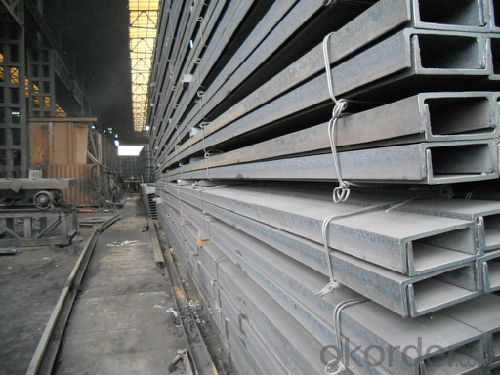
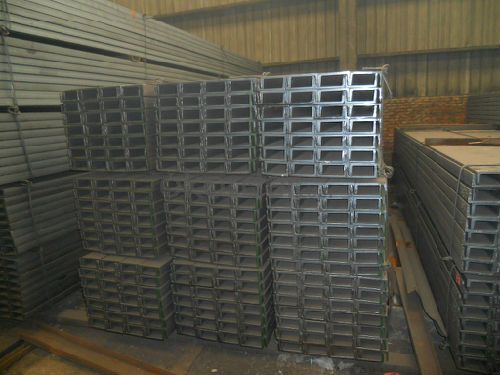
- Q: The types of channel steels are 6, 8, 10, 12, 16, 20, 25, 32 and 14. What are their tensile strength of these types of channel steel?
- No, it depends on what you use in that area. Many of them can be divided into tensile strength, yield strength and specific termsThe concrete formula does not seem to be available. Only by experiment can we get the exact number
- Q: What does "14 channel steel" do in the template "[14"?
- [this symbol means channel, and 14 is the height of channel
- Q: The telescopic arm is welded by channel steel and steel plate. Then the channel steel is inclined and the guide is not good enough. Is it a special profile? What are the telescopic arms?
- You think, is certainly the square and thick wall, to ensure the overall stiffness and strength.When the channel steel is welded together, how can the weld be treated? If the welded joint is too high, it will affect the expansion of the inner and outer walls Flat and can not, and it can not be welded inside, how to ensure that the intensity?In order to save money by not crane factory this rough steel welding method, and crane safety first, but once the problem is not trivial, does not rule out a small factory dare to do so, but definitely not the formal business.This kind of profile is formed at one time without any subsequent welding. It is a pressing forming sleeve with cold drawing technology!
- Q: Is there anything wrong with weight bearing? The total area of 15 square meters. The attic floor estimate 18MM blockboard, in addition to the requirements of the attic can go up two people outside bearing on it. Don't put articles, is a flat top and a heat insulation function. Can each channel be spaced 70 or 80 centimeters apart? In addition, 10, how much money a channel, the best is 9 meters a price of 6 meters is also ok.
- No channel steelWith 100~120 rectangular square tube or 120 C steel, two channel steel price can buy 3 square tubesThe board specification is 1.2*2.4m, so the steel beam spacing should be 60cm; the bone is 30*50 square tube and the spacing is 60cmThe span of 3.9m, bearing no problem, you can turn a somersault roll, O (a _ U) O~
- Q: Larry Midas in seeking to inform how to model such as: steel, double steel, double channel
- If civil is set in the channel, double cross section library inside, Larry is through the section properties of I-steel calculator, drawing DXF graphics in CAD, import
- Q: What are the different surface coatings available for steel channels?
- There are several different surface coatings available for steel channels, each offering unique benefits and characteristics. Some of the most common surface coatings for steel channels include: 1. Galvanized Coating: This is one of the most widely used surface coatings for steel channels. Galvanized coating involves applying a layer of zinc to the surface of the steel channel through a process called hot-dip galvanizing. This coating provides excellent corrosion resistance, protecting the steel channel from rust and other environmental factors. 2. Powder Coating: Powder coating is a popular choice for steel channels that require a decorative and durable finish. In this process, a dry powder is applied to the surface of the steel channel and then heated to form a protective coating. Powder coating offers a wide range of colors and finishes, providing both aesthetic appeal and enhanced durability. 3. Epoxy Coating: Epoxy coatings are commonly used in industrial and commercial applications where resistance to chemicals, abrasion, and impact is required. These coatings are typically applied via a two-part epoxy system, which creates a strong and durable protective layer on the steel channel's surface. 4. Paint Coating: Paint coatings are a versatile option for steel channels, offering both protection and customization. Different types of paints, such as enamel, acrylic, or polyurethane, can be applied to the steel channel's surface to provide an attractive finish and protect it from corrosion and weathering. 5. Stainless Steel Coating: For applications that require exceptional resistance to corrosion and harsh environments, stainless steel coatings can be applied to steel channels. These coatings are typically composed of a high percentage of chromium, which forms a passive layer on the steel's surface, providing excellent protection against corrosion. 6. Polymer Coating: Polymer coatings are often used in industries where a non-stick or low-friction surface is required. These coatings, such as polytetrafluoroethylene (PTFE), provide a smooth and resistant surface that reduces wear and prevents the accumulation of debris or contaminants on the steel channel. It is important to consider the specific requirements and intended use of the steel channel when selecting a surface coating. Factors such as corrosion resistance, durability, aesthetics, and environmental conditions should be taken into account to ensure the appropriate coating is chosen for the steel channel.
- Q: Are steel channels suitable for the mining manufacturing industry?
- Steel channels are an ideal choice for the mining manufacturing industry. They are widely used in various industries, including mining, because of their exceptional strength and durability. In the mining industry, where rugged conditions and intensive use are common, heavy-duty equipment and machinery are required. Steel channels, being made of a strong and sturdy material, can provide the necessary support and structural integrity to withstand the demanding requirements of the mining manufacturing industry. Furthermore, steel channels offer flexibility in terms of design and configuration, making them suitable for a wide range of applications within the mining industry. They can be used to construct frameworks, support structures, conveyor systems, and other equipment essential for mining operations. Moreover, steel channels have a high load-bearing capacity, which is crucial in the mining industry where heavy loads and vibrations are prevalent. They can efficiently distribute weight and handle stress, ensuring the safety and dependability of mining equipment and structures. Additionally, steel channels are resistant to corrosion, making them well-suited for use in the mining industry where exposure to moisture, chemicals, and other corrosive substances is common. This corrosion resistance extends the lifespan of the equipment, reducing maintenance and replacement costs. In conclusion, steel channels are an excellent choice for the mining manufacturing industry due to their strength, durability, versatility, and resistance to corrosion. They provide the necessary support and structural integrity needed for heavy-duty mining equipment and structures, making them a reliable option for various applications within the industry.
- Q: How do steel channels contribute to the flexibility of architectural designs?
- Steel channels contribute to the flexibility of architectural designs through their unique properties and characteristics. These structural elements offer several benefits that allow architects and designers to create more flexible and versatile structures. Firstly, steel channels are known for their high strength-to-weight ratio. This means that they can bear heavy loads while minimizing the overall weight of the structure. This attribute allows architects to design buildings with larger open spaces, longer spans, and taller heights, as the steel channels provide the necessary support without the need for excessive columns or other structural elements. This flexibility in design enables architects to create more open and aesthetically pleasing spaces. Additionally, steel channels are highly durable and resistant to various environmental factors, such as corrosion, fire, and extreme weather conditions. This durability ensures a longer lifespan for the structure and reduces maintenance costs. It also allows architects to design buildings that can withstand challenging environments, such as coastal areas or regions prone to earthquakes or hurricanes. The flexibility provided by steel channels in terms of withstanding different conditions gives architects the freedom to design structures in diverse locations and climates. Furthermore, steel channels can be easily fabricated, customized, and assembled on-site. This versatility in fabrication enables architects to create complex and unique shapes, curves, and profiles that add visual interest to the design. Steel channels can be easily cut, bent, and welded to create various configurations, allowing architects to bring their creative visions to life. This flexibility in customization also allows for easy integration with other building materials, such as glass, concrete, or wood, giving architects the ability to combine different materials for enhanced aesthetics and functionality. Moreover, steel channels are readily available and cost-effective. The widespread availability of steel channels makes it easier for architects to source the required materials, eliminating potential delays in construction projects. Additionally, their cost-effectiveness makes them a preferred choice for many architectural designs, as they provide an economical solution without compromising on strength or durability. In conclusion, steel channels contribute to the flexibility of architectural designs by offering a high strength-to-weight ratio, durability, customization options, and cost-effectiveness. These properties allow architects to design structures with larger open spaces, unique shapes, and increased resistance to environmental factors. The versatility of steel channels empowers architects to create aesthetically pleasing and functional designs that can withstand various challenges, ultimately enhancing the overall flexibility of architectural projects.
- Q: Can steel channels be used for roof truss systems?
- Yes, steel channels can be used for roof truss systems. Steel channels, also known as C-channels or U-channels, are commonly used in construction for their strength and durability. They can be formed into various shapes and sizes, making them suitable for various applications, including roof truss systems. Steel channels provide excellent structural support, making them ideal for bearing the load of a roof and distributing it evenly throughout the truss system. Additionally, steel channels have high resistance to corrosion, which is essential for withstanding the elements and ensuring the longevity of the roof truss system. Overall, steel channels are a reliable and efficient choice for constructing roof truss systems.
- Q: What are the different load-bearing tests conducted on steel channels?
- There are several load-bearing tests that are conducted on steel channels to assess their structural integrity and performance. These tests help determine the maximum load that a steel channel can bear without failure. Some of the different load-bearing tests conducted on steel channels include: 1. Tensile Test: This test measures the maximum tensile strength of the steel channel by applying a gradually increasing axial load until failure occurs. It helps assess the channel's ability to resist pulling or stretching forces. 2. Compression Test: This test determines the maximum compressive strength of the steel channel by applying a gradually increasing axial load until it buckles or collapses. It provides insights into the channel's ability to withstand compressive forces. 3. Bending Test: In this test, the steel channel is subjected to a gradually increasing load applied perpendicular to its length until it reaches its maximum bending capacity. It assesses the channel's resistance to bending or flexural forces. 4. Shear Test: The shear test measures the maximum shear strength of the steel channel by applying a force parallel to its cross-sectional area until it fails. It helps evaluate the channel's ability to withstand shearing forces. 5. Fatigue Test: This test involves subjecting the steel channel to repeated and varying loads over a specified period to simulate real-world usage conditions. It assesses the channel's resistance to fatigue and its ability to withstand cyclic loading. 6. Impact Test: In this test, a sudden and high-velocity load is applied to the steel channel to simulate impact or shock loading. It helps evaluate the channel's ability to absorb and dissipate energy without failure. 7. Buckling Test: This test is conducted to determine the critical load at which the steel channel buckles or collapses due to instability. It helps assess the channel's resistance to buckling under compressive loads. These load-bearing tests are crucial in ensuring the reliability and safety of steel channels in various applications, such as construction, manufacturing, and infrastructure. By conducting these tests, engineers can determine the load limits and performance characteristics of steel channels, allowing for informed design decisions and ensuring structural integrity.
Send your message to us
JIS Standard U-channel Many Sizes
- Loading Port:
- China Main Port
- Payment Terms:
- TT or LC
- Min Order Qty:
- -
- Supply Capability:
- -
OKorder Service Pledge
OKorder Financial Service
Similar products
Hot products
Hot Searches
Related keywords
